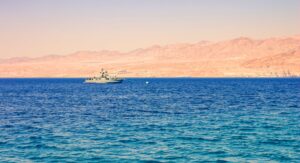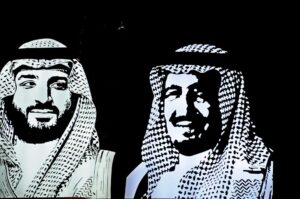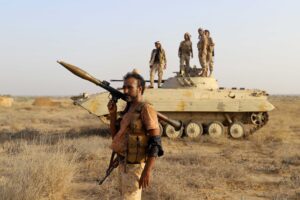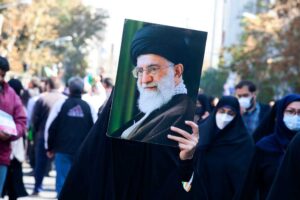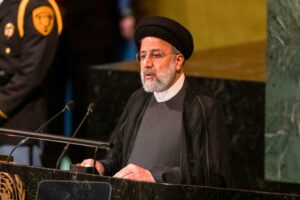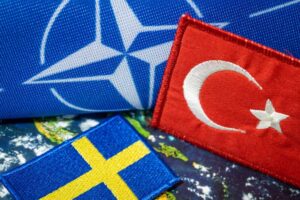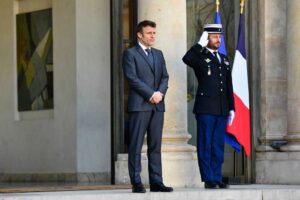The most consistent feature of the contemporary Middle East has been and continues to be Iran’s role in regional crises. Now, the Biden administration, like every U.S. administration since 1945, confronts the complicated issue of Middle East stability and Iran’s role in the region. Administrations inherit imperfect policies from their predecessors and seek to improve on them or chart new courses. Some marginally improve the situation and some fail miserably, which also adds new complications. None arrive at “The Solution” quite simply because “The Solution” or, as some would label it, “The Grand Bargain”, does not exist. Nevertheless, the arrival of the Biden administration brings renewed speculation about Iran, Tehran’s relations with Washington, and of course, the nuclear issue. Early on, the Biden administration demanded Iranian compliance with the 2015 nuclear accord as a precondition to lifting sanctions. Biden flatly stated that Iran could not be allowed to acquire nuclear weapons and called on Iran to end destabilizing regional policies. Airstrikes against Iranian proxies, who had operated with impunity in Iraq and Syria, underscored that the administration intended to back-up its warnings. In short, the Biden administration is not Obama-redux – there are real redlines – nor is it the simplistic, uncoordinated flailing of Trump. Biden’s approach to Iran has the earmarks of measured firmness and coupled with flexibility, but the question remains: will there be progress?1
In the 21st century relations between Iran and the United States have been disappointing. To be fair, both Obama and Trump policies should be considered partially correct. Obama’s Iran agreement alleviated the immediate critical issue of military action on the part of the U.S. and/or others who saw Iranian “breakout” as casus belli. Nevertheless, it merely kicked the nuclear issue down the road. With regard to the real strategic issue, of which the nuclear enrichment program was only a part, it did little to curb Iranian broader destabilizing activities. Iran complied with one important, but narrow, issue – nuclear enrichment; but it underscored Obama’s reluctance to engage in a more muscular strategic policy on other critical issues like missile development, nuclear physics package testing and research, and aggressive use of the Iranian Revolutionary Guards Corp (IRGC), its Quds-force, and proxies to expand its influence. At the beginning of his administration, Obama sought to declare victory and leave the region – Iraq 2011 – which is a shining example of how this approach backfired. By 2015, Obama understood that disengagement was not an option, but he no doubt hoped that the Iranian agreement would allow a reduced U.S. profile.
The Trump administration correctly criticized Obama for not holding Iran responsible on a broader set of issues, but through obtuse vacuousness and impulsive inconsistency, Trump managed to throw out the most useful Obama accomplishment, the nuclear agreement, while pursuing an ill-conceived “maximum pressure” campaign that was preordained to fail. On the one hand, Trump punished Iran economically, something hardly new or particularly debilitating to Tehran, and on the other, he refused to act resolutely against Iranian adventurism in Syria and Iraq.2 In fact, his drawdown of U.S. forces removed potential leverage with Iran. When the Trump administration did act by eliminating Major General Qasem Soleimani, commander of the Quds Force, in January 2020, the lack of a broader strategy to challenge Quds Force activities, coupled with the sharp Iranian response, further undermined U.S. credibility.3 Given the Obama and Trump baggage, what can the Biden administration actually expect to accomplish? Biden’s expectations must be limited to say the least.
Since the 18th century, Iran or Persia has attempted to reclaim what it views as its rightful dominant position in the region.
The problems of the last two decades notwithstanding, there is a far more problematic issue – namely the historical bequest of 300 years of Persian/Iranian humiliation. It is the cumulative heritage of the 1722 Safavid collapse, the 19th century ‘Qajariya’, British colonial policy, Russian interventions, and other slights both real and imagined including the 1953 Anglo-American coup.4 Since the 18th century, Iran or Persia has attempted to reclaim what it views as its rightful dominant position in the region. Thus, rather than just analyzing the tactical minutiae, there is a more fundamental question that must be asked – in geopolitical and socio-cultural terms, what is Iran? Why does dealing with Iran always take one step forward and then one or more steps backward? Why does the dynamic never really change?
The issue is the conflict between what Iran actually is, and what it believes it should be.
In simplest terms, the issue is the conflict between what Iran actually is, and what it believes it should be. The issues du jour change, but the long-term strategic problems remain remarkably consistent. In a very real sense, the issues with Iran, or Persia if you will, are less about external influences and forces – the United States, Europe, Russia, China, the Arab Gulf, even the Ottomans, etc. – and more about the nature of Iran itself. Focusing on isolated agreements or political developments like the next election, the latest policy statement or position, or on political jockeying merely mask the real issue – namely the Persian/Iranian experience of the last 300 years viewed in contrast with the “imagined” ideal of an imperial past that preceded 1722.5 Khomeini condemned “kingship” and then de facto embraced it or, as one historian described it, “the transition from one monistic political order to another, from the temporal absolutism of the Shah to the theocratic absolutism of Khomeini.”6 On the surface, such questions appear detached from the present; in reality, they go to the heart of the issue facing Iran’s leadership and undermining stability of the region.
In political and administrative form, Iran is the last of the great Middle Eastern empires. In short, the great globalization of the 18th century made the heretofore dominant “Gunpowder Empires” obsolete. Political control frayed at the periphery and corruption rotted the core.7 In the 19th and 20th centuries, try as they might, these great empires only existed at the convenience of the Europeans. All of their efforts to reform their societies and modernize their political and economic structures ultimately failed. The Mughal and the Ottoman Empires collapsed and the third, the Persian Empire, remained on life-support in the form of Iran for the geopolitical and economic benefit primarily of the British and to a lesser degree the Russian empires. As a result, Iran’s struggle to regain that which it ‘imagined’ it had lost, created a mantra of victimization that dovetailed well with the Shi’a heritage of persecution.8 Even in the 21st century, this experience provides the context from which the Iranian mindset and policy must be understood.
The tactical issues, some more important than others, must be evaluated and then placed within this much broader strategic framework from which a longer view and more prescient understanding might be derived. In this framework, contemporary Iran juxtaposed against its imperial past explains the chronic struggle for stability and influence as well as Iran as a source of geopolitical friction and instability. Iran, like Persia before it, continues to be a polyglot, multi-cultural state ruled by a political elite backed by a military and security apparatus, the latter being an absolutely necessity for cohesion. The state is run by and for the benefit of the political elite and its military and security support structure, which is in turn dominated by Persian clerical and elitist interests. The second and third tier support structure includes co-opted ethnic and sectarian leaders loyal to the regime’s leadership. In short, it is the Safavid, Sassanian, or Achaemenid Empires writ small. Iran sends its new military recruits to Persepolis to instill pride in past imperial glory, but this same imperial tradition is accompanied by an inherently unstable state structure. What are the implications for Iran’s contemporary predicament and the conundrum of facing those attempting to deal with Tehran?
Khamenei and the ruling Iranian elite view loss of internal political control as the primary threat to the Islamic Republic.
Iranian stability or instability, like that of Persia before it, is cyclical. State structure in the heterogeneous society is maintained through coercion and co-option; the alternative is fracturing and state collapse. Khamenei and the ruling Iranian elite understand this in no small part because they were the beneficiary of such a failure in 1979. They continue to view loss of internal political control as the primary threat to the Islamic Republic. Change potentially opens the door to loss of control. In that regard, Iran is entering a transformational phase — change complicated by a fluid regional and even global political and socio-cultural dynamic that poses a threat to the status quo. The Iranian leadership also fears that the anomaly of Khomeinism and the steady progression of Iran toward a more traditional Iranian-Persian political system – namely with the religious authorities in a supporting role to the military-security apparatus – could permanently alter the nature of the current state by aligning contemporary Iran with its historical Persian heritage.9 Viewed through this prism of a dead revolution, the real question about Iran becomes not what will happen but rather when and how it will happen. This, of course, has enormous implications for stability in the Greater Levant, the Gulf, and the potential of creating a global flashpoint because of the Iranian nuclear program.
Within this complicated historical context, political transitions have always been particularly difficult. In the 20th century alone, the political structure of Iran, or Persia, collapsed, suffered a coup, or suffered foreign occupation on multiple occasions.10 Each leadership change brought instability. In the relative near-term, Khamenei, the compromise of 1989, will pass from the scene and jockeying to replace him complicates any dealings with Iran. In comparison, the upcoming election is almost farcical. In 1979, there was a short-lived revolution that was undermined in a Thermidorian coup and the complications of the Iran-Iraq War. Supreme Leader Ayatollah Khomeini supported by a clerical-political elite, the Iranian Revolutionary Guard Corps, and its security services merely displaced Shah Mohammad Reza Pahlavi who was supported by a political elite, the military, and SAVAK. Khomeini instituted controlled elections supported by a populist movement – a mirror of the Shah’s attempt through the “White Revolution” of 1960s to broaden the base of his regime. In the post-Khomeini era, the trappings of the traditional Iranian or even the Persian state steadily reemerged under a different nomenclature with a cleric at the head.11
Khomeini had created a political system based on his personal rule, and that for it to survive politics took precedence over religion.
Ayatollah Khamenei succeeded Khomeini as the Supreme Leader, but only after the latter engineered a change in the Iranian Constitution; Khamenei was not religiously qualified to hold the office of Supreme Leader under the original Revolutionary Constitution. Khomeini made it clear that “political reliability” trumped religious qualifications.12 Khamenei’s earlier role as President of Iran during the war with Iraq and his close relationship with Khomeini, both personal and political, as well as his strong ties to the Revolutionary Guard, made him the preferred successor. Khomeini understood that he had created a political system based on his personal rule, a system based on his interpretation of wilayat-e fiqh, not traditional Shi’a political theory and that for it to survive politics took precedence over religion.13 Many political and religious leaders disagreed with Khomeini’s adaptation of Shi’a political practice and its authoritarianism. Ayatollah Hussein-Ali Montazeri Najafabadi (1922–2009) was Khomeini’s hand-picked successor and the foremost Shi’a religious scholar in Iran, but Khomeini disowned him on March 28, 1989 because of Montazeri’s increasingly open opposition to the harsher aspects of Khomeini’s rule and the prominence of the most conservative elements of the clergy.
The power of the IRGC has expanded significantly. After Khamenei, there is a real possibility that it will become the “kingmaker” behind whomever emerges as the next Supreme Leader.
Khamenei’s last-minute elevation was a political expediency. He lacked the authority, charisma, and the religious stature of Khomeini, with his rule becoming a balancing act between factions. Ultimately, Khamenei relied on his relationship with the IRGC, subtly compromising Khomeini’s version of wilayat-e fiqh. For over 30 years, Khamenei has skillfully balanced opposing forces in Iran to maintain power. During that same period, the power and influence of the IRGC and allied groups has expanded significantly. After Khamenei, there is a real possibility that the IRGC will become the “kingmaker” behind whomever emerges as the next Supreme Leader.14 In the context of the ongoing positioning for the role of Supreme Leader by multiple candidates, the power and influence of the IRGC and its allies will increase as will the difficulties of dealing with Iran. Thus, reimplementing the terms of the 2015 nuclear agreement will be a challenge, and a broader resolution of other regional security issues may in fact be impossible. Khamenei is ailing and his potential successors are likely unable and, certainly in most cases, unwilling to risk political capital or their heads. The situation does not bode well for improved relations or a reduction in tensions.
In addition, the Biden administration also faces tactical fallout from the 2015 nuclear agreement. For Iran, the internal debate over the 2015 agreement was torturous and divisive; while it culminated in an agreement with the West, the Iranian IRGC and its allies opposed it. The terms of the agreement required inspections by international organizations to verify compliance that were in fact violations of Iranian sovereignty. President Hassan Rouhani, the primary sponsor of the secret negotiations, convinced Khamenei that the economic benefits outweighed the benefits and risks of the nuclear weapons program. The agreement was signed with strong reservations on the part of Supreme Leader Khamenei, conservative political elements, and the IRGC.
Although the agreement removed most economic sanctions, the hoped-for economic benefits never materialized to the degree that Rouhani had hoped. In no small part, this was a function of the corruption within Iranian society and of IRGC control and intervention in the economy. Despite purported economic reforms, the IRGC continued to control as much as 40% of the Iranian economy.15 Trade agreements with the West and the push for economic transparency, including a crackdown on corruption, have the potential to put these assets at risk. Thus, the IRGC has both policy and economic reasons to oppose any real rapprochement. The nuclear agreement also became a shield behind which the IRGC and its Quds Force components continued ancillary work related to the nuclear and other weapons programs and aggressively intensified their interventions in Iraq, Syria, Lebanon, and Yemen. The perception, and perhaps the reality, was that these activities violated spirit of the nuclear accords, namely a move away from confrontation with the West, while at the same time, relieving economic pressure, allowing Iran to continue, if not increase, its aggressive provocations throughout the region. The problem lay in interpretation and the difference between the ‘reality’ and the ‘representation’ of Obama policy. The faulty perception of policy was increased when a senior Obama security official asserted that the administration “largely manufactured” “a dishonest narrative” to win support for the agreement.16 While the enrichment of weapons grade nuclear materials had been temporarily halted, peripheral work on a nuclear weapons capability continued.17 Then came the Trump administration’s unilateral withdrawal from the nuclear agreement and its “maximum pressure” campaign on Iran. It was a gift to the IRGC and opponents of the nuclear accord because Washington left the agreement looking like a bad-faith actor that could not be trusted. Trump undermined the more pragmatic political elements in Iran, including President Rouhani, whose priority was improving the economy. Nuclear enrichment resumed, and the Iranian policy in Iraq, Syria, and Lebanon became more aggressive.
The IRGC have insulated themselves through corruption and repression from the sanctions, economic stagnation, and Covid-19. No one is predicting an imminent collapse, but then no one really predicted the collapse of the Pahlavis or the Safavid collapse in 1722.
The issues impinging on Iran’s ability to move forward on nuclear disarmament and other security and stability issues in the Gulf and Greater Levant are formidable, perhaps even hopeless. Much will depend on just how dire Iranian leaders see their situation – politically, economically, and potentially militarily. In this regard, the fragility of the Iranian state may work in favor of progress. Iran, like Persia before it, has a record of periodic implosions. Even for the great Persian empires, sustained stability was elusive and dependent on the competence of the sitting ruler. Every transition of power brought with it the specter of instability. Never popular in many quarters, the ruling clerics and the IRGC preside over a state where they have insulated themselves through corruption and repression from the sanctions, economic stagnation, and Covid-19. No one is predicting an imminent collapse, but then no one really predicted the collapse of the Pahlavis or the Safavid collapse in 1722; nevertheless, it happened. None of this is lost on Khamenei, Rouhani, and others in the Iranian leadership. They know that a catastrophe can unravel even the most repressive regime.18
If Iranian leadership, and more particularly Khamenei, becomes convinced that a nuclear weapons program and/or aggressive adventurism in the region has created a determined existential threat to Iran, then there is the possibility that progress could be made. The regime would be forced to forego the mirror of their Persian past in which ‘defense’ and imperial expansion and meddling become indistinguishable in Iraq, Syria, Afghanistan, Lebanon, Yemen, etc. They are aware that the oil from their ethnic Arab regions greases the corruption within the regime. They are aware of independence movements among the Baluchis, Kurds, and Azeri minorities. They know that there is an educated middle class that generally despises them. The list of threats to the regime is long. Although unlikely, it is possible that Khamenei could decide that his parting gift to the Republic would be something of a grand bargain that would free Iran of its external security threats so that it could focus on internal security and economic recovery and stability. Issues would no doubt still remain, but such an agreement might even create a subtle wedge between the U.S. and its Arab Gulf allies enhancing Tehran’s regional leverage.
The Biden administration has stated that Iran must not be allowed to acquire nuclear weapons. Do Khamenei and other Iranian leaders want to find out if he is serious? Then, there is another Iranian adversary in the region with its own nuclear weapons, a demonstrated willingness to use force, its own heritage of victimization, and a grim determination not to repeat the past. Iran has an opportunity to play the long game and, in an integrated Gulf region, emerge as the dominant player, or it can risk everything on nuclear breakout in a fast-track attempt to claim its imperial heritage. While the former appears to be the more rational choice, the leadership in Tehran, with the expanding power and influence of the IRGC and its allies, may already be in a situation where they have no choice but to placate the hardliners and go for the breakout that they believe would ultimately assure regime survival and Iranian regional dominance – the dream of erasing 1722. Of course, the dream of a quick fix could potentially erase the Islamic Republic as well. How much progress can the Biden administration make with Iran on the nuclear problem and broader regional security issues? It is really up to Iran and the path that it chooses.
- Advisors are just that, and many of Obama’s advisors who worked on the 2015 Nuclear Agreement fully recognized its shortcomings and the necessity of vigorously pursuing and, if necessary, punishing Iran for other activities that undermined U.S. interests and the stability of the region. The Obama administration sold the agreement on the premise that the only other alternative was war (a debatable proposition) and ignored weaknesses in the agreement. The following article provides a solid analysis of Deputy National Security Advisor Ben Rhodes’ role in distorting the issue. Susan Maloney, “Deception and the Iran Deal: Did the Obama Administration Mislead America, or did the Rhodes Profile?” Brookings (11 May 2016): https://www.brookings.edu/blog/markaz/2016/05/11/deception-and-the-iran-deal-did-the-obama-administration-mislead-america-or-did-the-rhodes-profile/. Some are surprised by Biden’s firm stance on Iran. It is not Trump policy because there was no real policy, but it underscores the unrealistic expectations in some quarters for a Biden ‘policy revolution’ with regard to Iran. Assal Rad and Negar Mortazavi, “President Biden Must Follow the Advice of Candidate Biden on Iran,” Foreign Policy (10 March 2021): https://foreignpolicy.com/2021/03/10/president-biden-must-follow-the-advice-of-candidate-biden-on-iran/.
- Trump’s “maximum pressure” campaign is nothing new in the Middle East. For example, in the 1950s, Eisenhower’s administration attempted to unseat Gamal Abdul Nasser following the famous ‘Czech Arms deal’ of 1955. It failed ultimately leading to the Suez crisis and other events that damaged U.S. interests in the region. In 1958, U.S. policy reverted to a more pragmatic and sophisticated series of approaches that took advantage of Nasser’s own prejudices and regional interests and produced a workable and more successful approach to protecting U.S. interests in the region. The shift in U.S. policy between early 1958 and 1961 is a lesson in ‘learning curves.’ Unfortunately, the Trump administration lacked the capacity to learn and to adjust policy as Eisenhower did in 1958. On the one hand, it was a function of the global Cold War and on the other hand it was an opportunity created by what Malcolm Kerr in his excellent essay The Arab Cold War 1958-1967, A Study of Ideology in Politics (London: The Oxford University Press, 1967) described as an Arab nationalist ideological war of subversion. The Eisenhower administration concluded that Nasserism was “the wave of the future” but that it was anti-Communist at root. The term “wave of the future” became synonymous with Nasser and widely used. In Roby C. Barrett’s 2001–2004 interviews with Phillips Talbot, General Andrew Goodpaster, William “Bill” Lakeland, and Walt Rostow, each used the term at one point or another to describe the US evaluation of Nasser and the Nasserist wave that seemed to be sweeping the Arab Middle East. Most fail to realize that this shift in policy occurred before the Baghdad coup of July 1958. In April 1958, John Foster Dulles cabled U.S. Embassies in the region, “We have decided that effort should be made to place US-UAR relations on a more normal basis. Although under no illusion that Nasser’s basic philosophy or objectives can thereby be effectively altered to reflect pro-Western orientation, we nonetheless believe that removal of certain points of friction and minor irritants might help achieve this purpose and that it might place us in position to exert more effective influence over UAR policies.” Telegram from WDC to US Embassies in the Middle East and Europe, 25 April 1958,” National Archives – College Park Maryland (NACPM), GRDOS – 59, NEA, CDF 1955-1959, 611.86/4-2558 (Box 2555): 1-2. The point being – the U.S. has been here before, but there is no institutional memory of exactly what happened or how it happened. “Targeted pressure” is far more effective than “maximum pressure.”
- In the Iranian counterstrike, Operation Martyr Soleimani, against bases at Ayn al-Assad in western Iraq and Erbil in Kurdistan U.S. forces took over 100 casualties without responding. Sarah Almukhtar and Falih Hassan, “Map: How the Confrontation Between the U.S. and Iran Escalated,” New York Times (8 January 2020): https://www.nytimes.com/interactive/2020/01/03/world/middleeast/iraqem-bassy-baghdad-airport-attack.html?action=click&module=RelatedLinks&pgtype=Article.“The assassination of Soleimani makes the prospect of further negotiations on issues outside of the nuclear case, especially issues related to Iran’s national defense, more complicated,” explained Dr. Assal Rad, a senior research fellow at the National Iranian American Council. “Biden will have a tougher time establishing trust, and Iranian hardliners who are against detente with the US will use the killing as a reason against returning to the deal,” he said. Giorgio Cafiero, “Looking at the Soleimani Assassination, One Year Later,” The Medialine (16 March 2021): https://themedialine.org/news/-opinion/looking-at-the-soleimani-assassination-one-year-later/.
- For Iranian rulers, Shahs, or Ayatollahs, the 18th century is the beginning of 300 years of frustrated attempts to reassert Persian/Iranian preeminence in the Gulf and Southwest Asia. In 1722, the Safavid Empire collapsed when a tribal Afghan force captured Isfahan and forced the last Shah to flee. Exploitation and foreign intervention followed. In the 19th century, the rule of the Qajars was so inept and corrupt that the term ‘Qajariyya’ emerged as a reference to weak foreign dominated Iranian regimes. Replaced by the Pahlavis, Reza Shah attempted to reestablish the Kemalist version of an Iranian state only to be forced into exile by the British and Russians in 1941. This is the 300-year heritage of Iran and of the Islamic State. It represents baggage associated with sovereignty that no Iranian ruler can escape, making compromise with outsiders an extremely difficult proposition. Douglas E. Streusan, Islamic Gunpowder Empires: Ottomans, Safavids, and Mughuls (Boulder, CO: Westview Press, 2011): 157. As for the 1953 coup, the removal of Mohammed Musaddiq had broad support including Ayatollah Seyyed Mohammad Bihbahani, Ayatollah Ghasem Mostafavi Kashani (1882–1962) and Grand Ayatollah Hosain Tabatabi Burujirdi (1875–1961). Homa Katouzian, Musaddiq and the Struggle for Power in Iran (London: I.B. Tauris, 1999): 157 and Kenneth Pollack, The Persian Puzzle: The Conflict between Iran and America (New York: Random House, 2004): 117. From an inside perspective, Kermit Roosevelt, CIA Near East operations, had his own view of the coup in Iran. He refused to participate in British sponsored schemes to overthrow Nasser because of his popularity and perhaps because Roosevelt knew and liked him. “I tried to tell them that these operations never work, if you are going against the grain of events. You have to have so much going your way before you dare undertake them. First and foremost, you have to have the vast majority of the people behind you. We did in Iran. And you have to have a leadership that is better than the one in power and one that can take control. We had in Iran in the army and the power structure; and the shah himself was a very gentle and reasonable person, although later he turned into a tough customer.” James Srodes, Allen Dulles, Master of Spies, (Washington, D.C.: Regenry Publishing, Inc., 1999), pp. 460-461.
- Iran is a prime example of Benedict Anderson’s “imagined community”, a treatise on the artificiality of nationalism. For Iran, this is a particularly acute issue because of the role that Persia had multiple times in the Middle East. Past greatness is an ‘imagined” ideal that drives Iranian policy and dreams of reclamation. Benedict Anderson, Imagined Communities (London: Verso Books, 2006): 160. See also Christopher Bayly, Imperial Meridian: The British Empire and the World 1780–1830 (London: Longman, 1989): 55. Bayly discusses the decline, if not collapse, of the three great Muslim empires.
- Arjomand correctly argues that an understanding of Iran and the Revolution of 1979 should begin with the rise of the Safavid state in 1501 and the forced conversion of Persia from Sunni to Shi’a Islam creating a “dual system of authority.” There isn’t enough space to explain that fully, so 1722 will have to suffice. Said Amir Arjomand, The Turban for a Crown: The Islamic Revolution in Iran (Oxford: Oxford University Press, 1988): 5–6. In his excellent work on the Qajar period, Abbas Amanat offers a similar judgment, “The irony is not that the revolution [1979] removed an archaic institution from Iran’s political arena, but that it substituted an even more oppressive and arbitrary institution: the ‘Guardianship of the Jurist’ the premise by which Ayatullah (sic) Khomeini consecrated his hegemony and that of his successors.” Given its problems and stresses, “it is not difficult to foresee a fierce disruption” in the Iran state. Pivot of the Universe: Nasir al-Din Shah and the Iranian Monarchy, (London: I.B. Tauris, 1997): 448.
- The Iranian penchant for “corruption”, over and above “patronage”, is well documented from a western point of view. An Afghan general in the 21st century described patronage as “one-handed” graft, and corruption as “two-handed” theft. The IRGC is “two-handed”, but nothing particularly new. In 1810, Sir Harford Jones-Brydges, the British India Resident Agent in Persia, lamented his assignment there. “There is no country in the universe where truth is so totally disregarded, where the system of rule is at once so despotic and lax, where the ruled are so oppressed and depraved and consequently where the virtues of national faith, patriotism and morality are so little known, or at least so little practiced.” Malcolm E. Yapp, Strategies of British India: Britain, Iran and Afghanistan, 1789-1850 (Oxford: Clarendon Press, 1980): 66, 87. “Patronage”, often viewed in the West as “corruption”, is a necessity for the Iranian system to actually function; it is the only method through which to maintain power, and when it becomes too oppressive then there is an explosion. Having had a conversation with the Iranian Minister of the Interior Sadeq Mahsouli through his translator about my use of the term “Arabian Gulf” at the Bahrain Security Conference (25 February 2009), this writer inquired later about Mahsouli through an Arab diplomat who knew him. The diplomat explained that Mahsouli had resigned as Minister of Interior and told him that “he had met his goal of making a lot of money and the job just had too many problems to deal with.” The diplomat added that Mahsouli went from being “a poor engineer to having enormous wealth in just a few years.” The Islamic Republic is an imperial patronage state; Mahsouli could have been a minister for Abbas the Great or Mohammad Reza Shah and had the same experience.
- Roby C. Barrett, The Gulf and the Struggle for Hegemony: Arabs, Iranians, and the West in Conflict (Washington, D.C.: The Middle East Institute, 2016): 641.
- Khomeinism’s rejection of the tradition Shi’a paradigm will also be a driving force in increased Iranian intervention in Iraq in order to secure a pro-Iranian successor to the highly respected traditionalist Iraqi Shi’a spiritual leader, Grand Ayatollah Sayyid Ali al-Husayni Sistani. Sistani is a Najaf focused marja who rejects Khomeinism and its doctrine of clerical control over the state. The Iranians want the next Iraqi Grand Ayatollah to be more subservient to Qom, i.e., the Khomeinist Iranian deviation. Make no mistake about it, Sistani’s views like those of Ayatollah Montezeri before are a threat to the powers that be in Tehran. Khaled Yacoub Oweis, “Ali al-Sistani: the subtle ayatollah shaping politics in Baghdad,” N World (3 January 2020): https://www.thenationalnews.com/world/mena/ali-al-sistani-the-subtle-ayatollah-shaping-politics-in-baghdad-1.958716.
- The Qajar absolute monarchy collapsed in the Persian Constitutional Revolution of 1906-1906. Constitutional government effectively collapsed with the Anglo-Russian Conventional of 1907. During World War I, Iran was effectively occupied by Britain, Russia, and the Ottomans. The Constitutionalist Movement of Gilan again mounted against the Qajars lasted from 1915 to 1921. Reza Shah established the Pahlavi dynasty in a 1925 coup. In 1941, was then deposed and occupied by the British and Russians because of his Iranian nationalist aspirations led to pro-German political positions. An unstable constitutional government ensured from 1947 to 1951, and then came the rise of Mohammed Musaddiq as prime minister. Musaddiq was deposed briefly in 1952 and then permanently in 1953 in the Anglo-American sponsored coup. Mohmmad Reza Shah’s rule had three distinct parts: 1953–1958; 1958–1973; and 1973–1979. Then came the Revolution of 1979 and finally the Thermidorian consolidation of 1980-1981 under Khomeini. This historical instability is the driving force behind Islamic State repression.
- In 1963, having survived a period of turmoil and instability, Mohammad Reza Shah decided to broaden his base of support by introducing a controlled plebiscite and creating two controlled political parties. The idea was to expand his base of support and provide a political outlet for mass participation while at the same time controlling the outcomes, an approach not unlike that of the Islamic Republic with its approved lists. The Islamic Republic has been more successful than the Shah. The Shah called it the “White Revolution.” “Memorandum from Komer to Bundy, April 30, 1963,” John F. Kennedy Library (JFKL), Presidential Papers of John F. Kennedy (PPJFK), NSF, Country Files, Iran (Box 116A): 1. See also, “Memorandum from Hansen to Komer, May 7, 1963,” JFKL, NSF, Komer Series (Box 424): 1.
- Roozbeh Safshekan and Farzan Sabet, “The Ayatollah’s Praetorians: The Islamic Revolutionary Guard Corps and the 2009 Election Crisis,” Middle East Journal (Autumn 2010): 547. This article discusses Khamenei’s elevation to Supreme Leader and argues that it was the decision of the Guardian Council and the more conservative elements that took control with the death of Ayatollah Khomeini. This is a distortion —Khomeini’s political home, despite his balancing act, was with the conservatives. Khomeini arranged for the conservatives to control the Guardian Council on his death, and he put Khamenei in position to become supreme leader. Khomeini approved Khamenei because he was a hardliner with strong ties to the IRGC and the security services and would defeat any attempts to liberalize. Barrett, The Gulf, 422.
- Wilayat-e fiqh is the theological justification defining the role of the Shi’a clergy in post-Safavid (1500–1722) Persia and Iran. The term literally means the “guardianship of the jurist.” Shi’a Islam is far more structured and hierarchical than Sunni or orthodox Islam. In Shi’a Islam, the most learned scholars or ayatollahs use reason and logic to interpret scripture and determine what is Islamic and what is not. Under traditional interpretations, their role is quietist, meaning that the clergy only rarely becomes directly involved in politics, but rather admonishes political leaders in cases where they have strayed from the Shi’a Islamic path to return to it. There are exceptions. At times, when the Shi’a clergy concluded that the very existence of the Persian nation was threatened, they took a more active role. The Persian revolt against the British tobacco concession in the late 19th century is an example, but these instances were rare. In the 1970s, perhaps as a result of his exposure to the more political active Iraqi Shi’a clergy in Najaf where he was exiled, Ayatollah Khomeini developed his own innovation on wilayat-e fiqh. Khomeini argued that guardianship of the jurist meant direct political oversight, even direct rule. He argued that the institution of kingship was an illegitimate non-Islamic political development and that only the jurist had the right to rule as the “Shadow of God.” Hence, the ultimate authority in post-1979 Iran has been the supreme leader or supreme jurist supported by the Council of Guardians to which the entire political system must answer. Much of the clergy continues to hold to the old interpretation, but those sharing Khomeini’s view rule Iran. Ervand Abrahamian, Khomeinism: Essays on the Islamic Republic (Berkeley: University of California Press, 1993): 21.
- The traditional power structure in Iran and Persia has been a ruler at the top who was to a greater or lesser degree, depending on his individual abilities, dependent on the military and a security apparatus to maintain his power. He was also supported by a political elite whose power and influence were inversely proportional to that of the ruler. Religion provided ideological legitimacy to the regime and the political system. This is not just an Islamic period phenomenon, whether Sunni or Shi’a, but also applied in earlier empires, i.e., the relationship between Sassanian rulers and Zoroastrian clerics. Khomeini’s unique role and his new interpretation of wilayat-e fiqh and the role of the Shi’a clergy as active overseer of the state effectively stood historical tradition on its head. It placed the clerics over the head of state and the government, including the military and security forces. Khomeini’s position was fundamentally unassailable – Montezeri’s removal is a good example of his power, and he chose a successor whose power was based on a relationship with the IRGC, his political skill, and most of all the fact that Khomeini made him his successor. This situation was a compromise with regard to Khomeini’s original intent of naming the best qualified religious leader. The change was a political decision that required a Constitutional change. The next Supreme Leader will not have the cachet of being Khomeini’s anointed candidate, nor will the next leader have the wartime relationship with the IRGC that Khamenei enjoyed. Granted there may be close ties and a history of cooperation, but those will be political and not forged in war. In addition, the IRGC is stronger and plays an even greater role in the state and economy than it has in the past. As a result, the next Supreme Leader will likely be relatively weaker than Khamenei and thus more susceptible to IRGC influence in what could be a progression toward the dominance of the security services and IRGC in affairs of state. This progression would better fit the Iranian political model and would have implications for the future, opening up the possibility that at some point the clergy might find itself back in the madrasas.
- Ladane Nasseri, “Why the U.S. Is Targeting Iran’s Revolutionary Guard,” Bloomberg (April 9, 2019): https://www.bloomberg.com/news/articles/2019-04-09/why-the-u-s-has-targeted-iran-s-revolutionary-guard-quicktake
- Maloney, “Deception and the Iran Deal.” Maloney believes that the Obama administration arguments in support of the Iran agreement were not “lies” per se, but that the statements of Ben Rhodes, the Deputy National Advisor, were a misrepresent of the positions taken by the administration. Regardless of the actual intentions or policy positions of the administration, the fact that Rhodes would state that the arguments were “largely manufactured” opened the door to questions about the deal and its temporary nature. See David Samuels, “The Aspiring Novelist Who Became Obama’s Foreign Policy Guru,” New York Times (5 May 2016): https://www.nytimes.com/2016/05/08/magazine/the-aspiring-novelist-who-became-obamas-foreign-policy-guru.html. “In the narrative that Rhodes shaped, the ‘story’ of the Iran deal began in 2013, when a ‘moderate’ faction inside the Iranian regime led by Hassan Rouhani beat regime ‘hard-liners’ in an election and then began to pursue a policy of ‘openness,’ which included a newfound willingness to negotiate the dismantling of its illicit nuclear-weapons program.” Both the timeline and the narrative in the Rhodes account has been labelled as false given the negotiations began before the rise of Rouhani, but more perhaps more importantly it ultimately undermined the ‘pragmatists’ in Iran and served to create false expectations for the ‘atmosphere’ surrounding the agreement. Coupled with continued work on missile delivery systems and related programs as well as what many in Washington viewed as Iranian subversion in the region, this statement lent credibility to the arguments that the Iranians were not serious about de-escalation in the region or about long-term adherence to the nuclear agreement – hence they were in violation of the spirit of the accords.
- Michael Elleman, “Iran’s Ballistic Missile Program,” The Iran Primer—United States Institute of Peace (13 January 2021): https://iranprimer.usip.org/resource/irans-ballistic-missile-program. See also Julian Hattem, “Obama: Iran Not Following Spirit of the Deal,” The Hill (1 April 2016): https://thehill.com/policy-/national-security/274954-obama-iran-has-followed-letter-but-not-spirit-of-nuke-deal. “The Trump Administration and the Iran Nuclear Deal: Analysis of Non-Compliance Claims,” The Carnegie Endowment for International Peace (29 September 2017): https://carnegieendowment.org/2017/10/12/-trump-administration-and-iran-nuclear-deal-analysis-of-noncompliance-claims-pub-73214.
- The Iranian leadership is well aware of the security implications of their heterogenous society. Perhaps their greatest fear is that some catastrophe might bring a chain reaction that would undermine the security structure of the state and fracture it. They are well aware of their own centrifugal forces, and the example of Iraq is not lost on them. In 2017, military and security officials hosted a series of meetings with two former senior intelligence and security officials from the Gulf region, one Arab and one Iranian. In one of the limited attendance sessions, the officials were asked about the possibility of another war in the region fracturing the Iranian state in similar fashion to what happened in Iraq. Both officials were clearly disturbed by the mere thought of such an event – war and fracturing – and the implications for stability, but interestingly, the reactions and the discussions clearly indicated that both thought that such an outcome was not farfetched at all but rather a possibility. Gulf Security Meetings and Discussions 2017 at Joint Special Operations University. In addition, it must be remembered that the end of the Iran-Iraq War in large part resulted from the Scud attacks on Tehran and other cities that resulted in mass migrations from the cities and effectively undermined the ability of the Iranian government to even function. Coupled with the U.S.S. Vincennes downing of the Iranian airliner and growing support for Iraq, Khamenei and others convinced Khomeini to “drink from the bitter cup” and possible collapse of the Islamic State. Nevertheless, the possibility of a loss of control or political collapse caused even Khomeini to blink. See also Shireen T. Hunter, Iran and the World (Bloomington: University of Indiana Press, 1990): 120–121. Iranian officials bitterly resented what they saw as the U.S. role in orchestrating this outcome. Participant in teleconference with Iranian working group and Mohammad Javad Zarif, Iranian Ambassador to the U.N. 2006.




